AN IMPORTANT ORGAN THAT CONNECTS THE MOTHER TO THE BABY.
Hello hivers it's wonderful coming on here once again to discuss an interesting and important topic. I must really say it's been a while but all thanks to passion i was able to create time to come on board. I have been discussing topics relating to mother and child and that is because am a midwife as well as nurse so it's fun to me telling us things I see daily in the course of practice which I know have been beneficial to many here.
Today I will take us through an interesting topic which I know we all as humans passed through to get to where we are now but so many do not have the idea or have not taken time to think through it or ask questions.
There is an important organ specifically in the body of a woman that forms a channel between the woman and the baby. At this juncture, some persons already know the organ am referring to while some are yet to know. Well let me go straight to the point. This important organ I will be discussing today is called the placenta.
Having Mentioned it, I would love to encourage us to patiently go through this post because I will simplify it for easy understanding, it will be interesting and you will have a lot to learn from it which might benefit you directly or people around you. So let's ride on.
THE PLACENTA.
The placenta is known as an important organ which plays an important role during the period of pregnancy for both the baby and the mother. This organ is so important that I will say there can't be pregnancy without the placenta in the picture, that's to explain how essential it is. The placenta normally is not part of the organs of the human body, it only develops immediately after fertization and implantation has taken place in the uterus. The placenta is known to have a pancake like shape and it's size varies in different individuals and situations, it's weight is usually 1/6th the babies birth weight.
PARTS OF THE PLACENTA
This organ has different parts that makes it up which helps it in carrying out it's functions. This parts are majorly divided into 3 which includes: the disc shaped placenta, the membranes and the umbilical cord
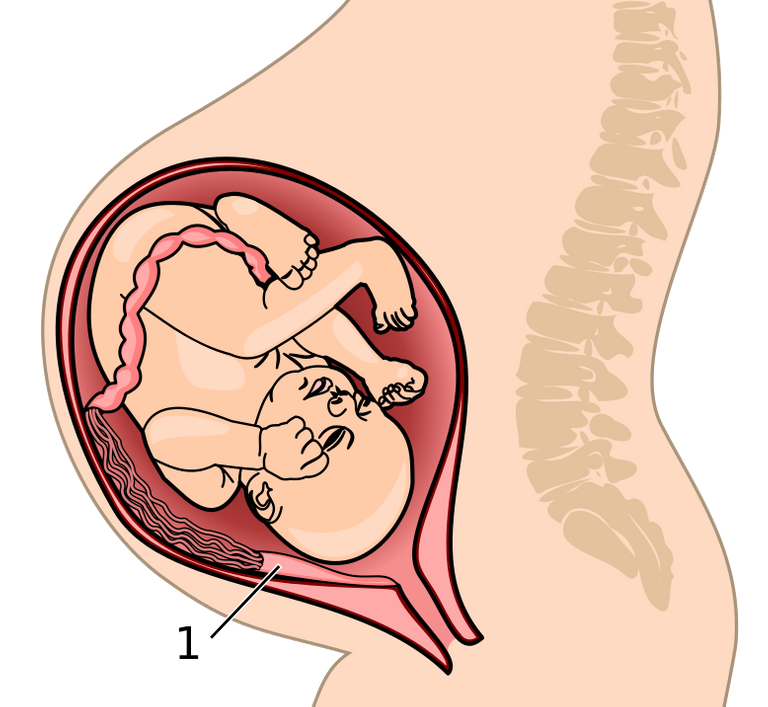
The placental system in pregnancy
The disc shaped body(placenta)
This is the major part which connects the baby to the mother. It has two parts or surfaces the maternal surface which is attached or buried directly to the wall of the uterus (endometrium) and the fetal surface which is in contact with the baby in utero.
The maternal surface is reddish in Color because of the blood from the maternal uterine surface. It also has lobes which are known as cotyledons and an average number of 16 to 20 cotyledons are found in a placenta. It is usually embedded at the upper lateral part of the uterus.
The membranes
The placenta is made up of membranes which are usually known as the chorioamniotic membrane this membrane is usually fixed to the fetal surface of the placenta and it encloses the baby in the uterus. It has two parts the amnion and the chorion.
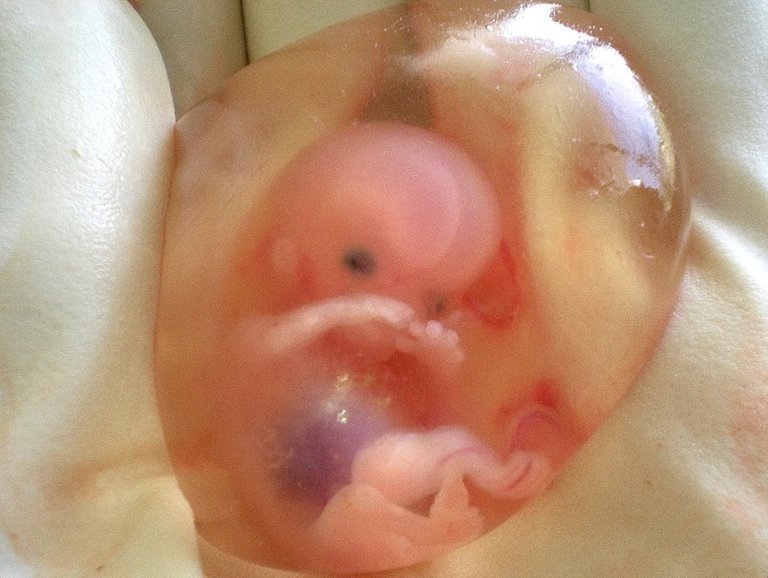
The fetus inside the amniotic sac during the first trimester of pregnancy
The amnion which is the inner most membrane, has a shiny transparent surface and is fragile in texture. It is the membrane that is in direct contact with the amniotic fluid and the baby. It has no blood supply to it, because of its fragile nature, the chorion encloses it to give it further protection. The chorion is opaque in nature and stronger than the amnion and is attached to the base of the placenta, it is whitish in color.
The umbilical cord
This is the rope like structure that directly connects or links the fetus to the mother. Usually, it is fixed to the middle part of the placenta and links to the fetus through the abdominal wall. The umbilical cord is the channel through which many processes takes place between the mother and the baby. It's average length is between 40cm to 50cm although in some cases it could be abnormally long or short.
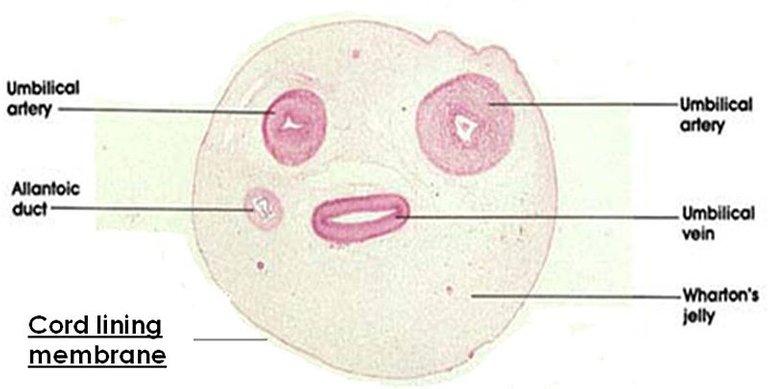
Cross section of the umbilical cord with the blood vessels
Umbilical cord can be detected on ultrasound by 6 weeks of gestation and well-visualised by 8 to 9 weeks of gestation
It encloses three blood vessels which play major roles in the function of the placenta.
These blood vessels includes: two umbilical arteries and one umbilical vein and these blood vessels are surrounded by the wharton's jelly within the umbilical cord that is gelatinous in nature and plays a major role in protecting the vessels.
The umbilical vein has the responsibility of carrying blood rich in oxygen (oxygenated blood), as well as food nutrients from the placenta to the the fetus, while the umbilical arteries carries deoxygenated blood (less oxygen) away from the fetus back to the placenta.
The blood flow through the umbilical cord is approximately 35 ml / min at 20 weeks, and 240 ml / min at 40 weeks of gestation.Adapted to the weight of the fetus, this corresponds to 115 ml / min / kg at 20 weeks and 64 ml / min / kg at 40 weeks.
Usually, these blood vessels closes after some time when the extra uterine life commences. In all these, the umbilical cord have some abnormalities that can occur in it but that will be discussed may be in my subsequent posts.
Having discussed the placenta and the onset of it's existence, I think it will also be important if I talk about the process of delivery of the placenta which is an important aspect of this topic.
PROCESS OF PLACENTA DELIVERY
Like I said earlier, am trying as much as I can to simplify this topic inorder to carry everyone along. So back to the discussion. The process of placenta delivery takes place during the third stage of labour. I know some persons will be like how many stages of labour do we have? So to further clarify us, labour being the processes involved during the childbirth, has 3 major stages comprising of uterine contraction and dilatation of the cervix to the delivery of the baby and then to the delivery of the placenta which is the third stage and according to some school of thoughts,the fourth stage being 1 hour post placenta delivery.
Procedure
• After the baby is delivered, the umbilical cord is usually clamped and cut to separate the mother and baby and this marks the beginning of the baby's extra uterine life.
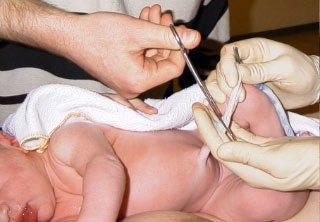
Cutting of the cord after delivery
• Next oxytocin injection is administered intramuscularly on the thigh of the woman while some intravenously by adding it into an infusion of Normal saline to go in slowly and this is to help facilitate uterine contraction, prevent bleeding and aid the process of placental separation from the walls of the uterus (womb) for easy delivery to prevent postpartum bleeding in the woman.
This stage is very vital during the process of delivery because mismanagement could cost the life of the woman through bleeding.
There are various methods that can be used during the process of delivery of the placenta though two out of all are commonly used in practice especially in my country and these two are the control cord traction method and the manual methods. Both methods of placental delivery requires experience as anything can go wrong if not done properly. In the control cord traction, artery forcep is usually used in which the remaining part of the umbilical cord is rolled round it completely and gentle pulling force is applied inorder to aid the separation process and delivery of the placenta. Adequate care is also applied during the pulling process inorder for the cord not to separate from the placenta through cutting.
The manual method simply involves the use of hand in separating as well as delivering the placenta from the uterine wall and it's done through insertion of the sterile gloved hand through the vagina into the uterus. This is usually done by either a trained midwife or an obstetrician in standard conditions although most times its being practiced by traditional birth attendants (TBAs) in rural areas.
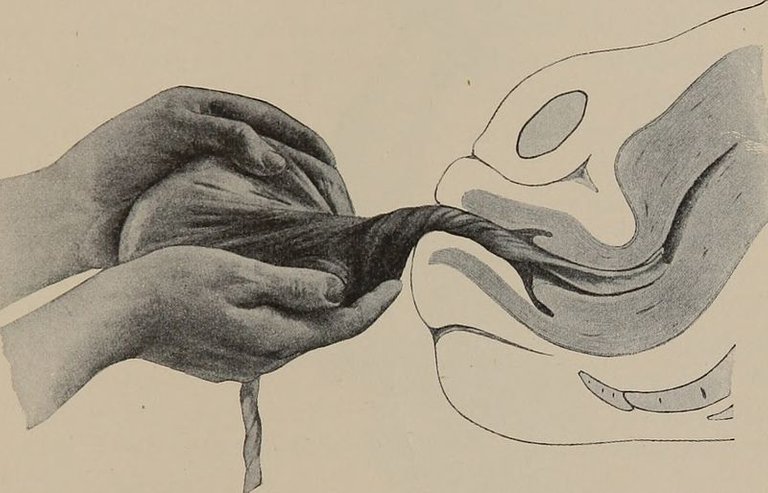
The manual method of placenta delivery
• Immediately the placenta is delivered, it is checked for completion to ensure no part of it is missen and this is usually done under running water so as to clearly see it. In addition, the uterus is further checked to ensure nothing like blood clots or remains of placenta which could cause bleeding is in it and this is done through the insertion of a gloved sterile hand into the uterus to clear it of any remains. After which the placenta is weighed.
That's all for the process of delivery of the placenta. Another important thing in this discussion is to know the the functions of this placenta during the period of pregnancy because it may not really make sense not knowing it's importance so let's continue.
WHAT ARE THE FUNCTIONS OF THE PLACENTA DURING THE PERIOD OF PREGNANCY?
This organ has numerous functions during the gestation period (pregnancy) but I will be discussing briefly only seven which are the major functions and they include :
✓ Transportation function
The placenta serves as the channel in the transportation of blood which is rich in oxygen (oxygenated blood) as well as nutrients from the mother to the baby (fetus). Without this the baby will not be able to get it's necessary nutrients for adequate growth and development in utero. In some conditions where the cords are knotted, the transport system will be altered which most times leads to the death of the baby.
✓ Excretion of waste
Waste products from the baby is usually removed and transfered to the mother through which it's gotten rid of and this is possible through the help of the placenta. Some of these waste products are carbon dioxide, urea and creatinine which are harmful to the body if not removed.
✓ Protection
The placenta plays a protective role for the baby during pregnancy because it's through it that the baby gains immunity against diseases in utero through the transfer of antibodies from the mother to the baby. Also, the placenta serves as a barrier against some substances and drugs which could be harmful to the baby that the mother consumes during this period of pregnancy and this is through the action of the placental barrier, although some harmful substances like nicotine and caffeine can pass through this Barrier which is the reason why they are discouraged during pregnancy.
✓ Endocrine function
This organ helps in the secretion of some hormones which play crucial roles during the period of pregnancy in encouraging the growth and maturation of the baby as well as the placenta and the mother as well. These hormones includes estrogen, Human placental lactogen and progesterone.
✓ Gaseous exchange
The placenta helps in the exchange of gases between the fetal and maternal circulation and some of these gases are the oxygen and carbon dioxide. The oxygen is carried to the fetus from the mother,while carbon dioxide from the fetus is carried to the mother and this is through the help of the blood vessels.
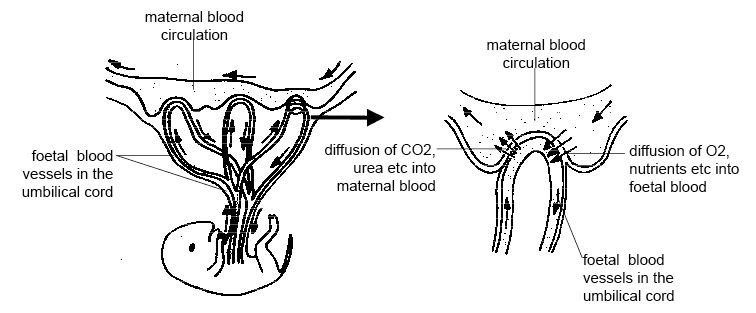
Gaseous exchange functions of the placenta
✓ Nutritional function
The placenta helps in the provision of adequate nutrition for the baby in utero like glucose,amino acids from proteins,lipids, minerals and vitamins as well as other vital nutrients that will help in the maturation and growth of the baby all through its life in the womb. The amount of nutrients available for the baby during this period of pregnancy will determine how fast and well the baby grows and develops.
✓ Storage function
The placenta helps in the storage of glucose in the form of glycogen as well as fat storage for the baby during this period till the organs develops.
Wow! I think I have really done justice to this topic atleast to a great extent and I hope we learnt something from it? I will be glad getting meaningful and encouraging supports and inputs from everyone here. Anticipate my next post which may likely be a continuation of this one, it will really be interesting as I will be discussing some abnormalities or disorders of the placenta. Thanks a lot for your time.
Reference
They told me if I killed myself now it would save the lives of countless others.
Saying the longer I wait to kill myself the more people will suffer.
They are reckless and should have shown the proper media what they had before taking me hostage for 5 years. I know there are many in prison that dont deserve to be there because of this. Your stay in prison will not be fun @battleaxe and friends. People are going to want you dead when they find out what you did. I hope you die a slow painful death. You sick mother fuckers.
https://peakd.com/gangstalking/@acousticpulses/electronic-terrorism-and-gaslighting--if-you-downvote-this-post-you-are-part-of-the-problem
Its a terrorist act on American soil while some say its not real or Im a mental case. Many know its real. This is an ignored detrimental to humanity domestic and foreign threat. Ask informed soldiers in the American military what their oath is and tell them about the day you asked me why. Nobody has I guess. Maybe someone told ill informed soldiers they cant protect America from military leaders in control with ill intent. How do we protect locked up soldiers from telling the truth?
The more I read, the more it got me glued to know more in addition to what I already know
There are indeed far more than just theories in book. Sharing Experience in practice makes learning more interesting.
Lovely article.
Wow I'm really happy to know that my post captivated you. Evidence of a great mentorship. Truly experience has a lot more to teach us in our career and professions in addition to our theoritical knowledge from school.
Congratulations @nazom! You have completed the following achievement on the Hive blockchain and have been rewarded with new badge(s):
Your next target is to reach 100 comments.
You can view your badges on your board and compare yourself to others in the Ranking
If you no longer want to receive notifications, reply to this comment with the word
STOPTo support your work, I also upvoted your post!
Check out the last post from @hivebuzz:
Support the HiveBuzz project. Vote for our proposal!
The simplicity by which many women deliver placentas after birth makes many forget that it is actually a very delicate process that can cost life.
Also, I am certain that administering oxytocin is not compulsory, otherwise, people will not be delivering successfully at home (I know a couple of women that did in the past). What do you think?
Yes what you said is actually true in some cases but doesn't mean it's right. Just as some people go on a heist and go scot free or commit an offence and go scot free, that's also the same way nature helps these people to go scot free even without the administration of oxytocin, while many too have died due to such practice atleast I have experienced some cases. The most important thing is this, this medication helps in preventing such ugly incidents from occuring it increases the level of the oxytocin in the body to enable fast separation and delivery of the placenta within 30minutes after the baby is out to prevent bleeding which may occur with more delay that is why it's very very vital to administer inorder to save yourself unnecessary risk and stress that could occur after delivery.
Of course, I know the importance of administering oxytocin. I have witnessed my wife giving birth twice now, so I can say what it is like firsthand.
I hope I have answered your question
Thanks a lot for this detailed and instructive blog. I have a basic and naive question relative t the umbilical cord. Is it considered as an organ on its own, or is it part of the placenta? This is unclear to me from reading your blog. Thanks in advance for your answer.
On a more weird side, have you heard about those people eating placentas because of certain myths? I remember having read about this in the past (on Hive in fact), and I was a bit shocked by such a behaviour…
Have a nice week-end!
Thanks @lemouth for your question and inputs it's really been a while I must say and am happy you back 😊.
Coming down to your question, it was quite a thoughtful one. Actually, the umbilical cord is a fetal organ which has more of a conduit function. It can't perform it's functions without the placenta being there and that is why it is connected to the placenta.
In my post, I grouped it as part of the placenta inorder to explain or paint a clear description of what it looks like because looking at it physical, both are connected and both of them as well depend on each other to carry out their functions.
But it's actually a fetal organ.
Coming down to what you said about people eating it, it could actually be true even though I haven't heard about that, but what I know for sure is that it is used in the production of some hair cream or treatment products for women as it's seen to speed up hair growth though I haven't taken time to find out how it does that. Thanks once again for your input, I hope I was able to answer your question?
It has indeed been a while. I have been through two very busy weeks (you can check out my last post for some information with this respect if you have some time).
Thanks for the clarification on the placenta/umbilical cord. If I got it well, it is thus an organ on its own but it is definitely paired with the placenta, so that one cannot function without the other. Am I correct?
To me, this story with placenta-made cream sounds like a big scam. I will try to dig into this if I have some free time during the week-end. I am however pretty convinced this is a myth too.
Cheers!
Exactly that's how it is, am glad you understand clearer now. I would really love to know the outcome of your findings from the use of the placenta. Thanks once again for your contribution and welcome back. I will take out time and go through your post.
Almost all animals that produce a placenta eat it to replenish nutrients. The same concept is true for products that contain placenta nutrients such as hair treatments and skincare. People have been doing this strange thing with the placenta for many years. In the US, it began in the 60s or 70s, but the Chinese use of placentophagy dates back 2000 years for it's anti-aging properties! In modern times, mid-wives process the placenta and put into capsules so it is easier for the mother to take. It is thought to be beneficial to women who may be susceptible to post-partem depression. Why do some people eat their placenta?
More interesting articles...
Eating Placenta - An Age-old Practice in Chinese Traditional Medicine
Illegal Placenta Trade Still Rampant In China, But Why Do Chinese People Eat Them?
One more funny story... When my oldest daughter was very young our cat had kittens. After each kitten was born, our cat would devour each placenta. My daughter was so disgusted, she said "Eww what is she doing??? That is so gross!!!" I explained to her that lots of mammals do this to replenish nutrients after birth. She asked if people do it too hahaha
Just fyi... I had three normal, healthy births. I never once even thought about placentophagy 🤣 I choose to eat my veggies instead lol
Wow! Thanks for throwing more light on this practice of eating of placenta, it's actually weird to me though.
I think it's very weird to most. The first time I heard about it I was like what in the world 😂
Thanks for your contribution to the STEMsocial community. Feel free to join us on discord to get to know the rest of us!
Please consider delegating to the @stemsocial account (85% of the curation rewards are returned).
You may also include @stemsocial as a beneficiary of the rewards of this post to get a stronger support.
https://twitter.com/BenjaminFuks/status/1522492633188347905
The rewards earned on this comment will go directly to the person sharing the post on Twitter as long as they are registered with @poshtoken. Sign up at https://hiveposh.com.
I know that is a summarized version of the whole topic, but, still a long read for me. It contains detailed information though. 🙂
!1UP
You have received a 1UP from @thecuriousfool!
@stem-curator, @vyb-curator, @pob-curator, @neoxag-curator, @pal-curatorAnd they will bring !PIZZA 🍕
Learn more about our delegation service to earn daily rewards. Join the family on Discord.
Beautifully written! Love to read your posts. Looking forward to many more 😊
Thanks a lot , am so glad that my post interests and benefits you.